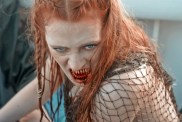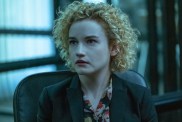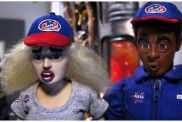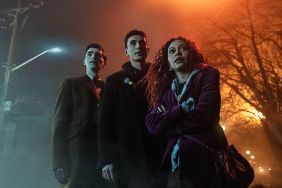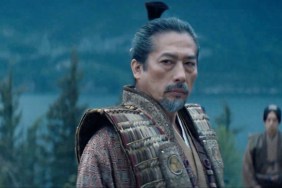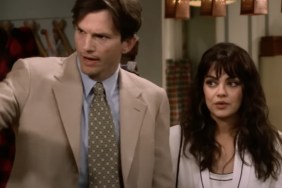Preface: Check out our set visit preview for a fist full ‘o action!

It’s a bad day for Big Figure.
His twenty year grudge against Rorschach (aka Walter Kovacs) has led him to a poorly designed revenge scenario that will leave one of Big Figure’s thugs soaked through with toilet water and thoroughly electrocuted on the floor of Rorschach’s prison cell. And Figure, well, he’ll be high-tailing it as fast as his little legs will carry him away from Rorschach.
Fans of Alan Moore’s Watchmen – the ’86 graphic novel often bandied around in passionate conversations affixed with praises like “milestone” and “seminal” and “masterpiece” – will no doubt recognize the above scene from the book’s prison break sequence. And director Zack Snyder (300) is relishing the mayhem requested for this moment. “Big Thug goes into the toilet bowl, smashes it open, water spills out, Jackie jumps up and Big Figure runs away,” reiterates Snyder. “[Jackie] then has his line about disposing the sewage in toilet bowl.” That would be, “Never disposed of sewage with toilet before. Obvious, really.”
It’s October. 2007.
ComingSoon.net/Superhero Hype! has flown up to Vancouver to drop in on the long-gestating big screen adaptation of Watchmen, the project that has placed Snyder under much scrutiny. Nearly a month into shooting, Snyder reflects confidence and reverence for the film’s source material as he sits with us in a section of an old paper mill that has been redressed to look like a prison. The crew around us is prepping for the scene. Nearby, actor Jackie Earle Haley – lean, scrappy, a flock of red hair on his head – does shoulder presses with two weights (60lbs. or so each) in his blood-splattered cell. Danny Woodburn, most recognized for his turn on “Seinfeld,” is playing Big Figure.
“You get Danny being Big Figure, saying ‘Just open the door so I can smell this son of a bitch cookin’!’ – it’s got a quality to it you don’t imagine reading, but when you see it in a movie…” Snyder doesn’t complete the thought, he just laughs. We understand what he’s getting at. Although Snyder is remaining very faithful to Moore’s material, right down to lifting dialogue, Watchmen is taking on a life of its own as evident in this scene. “It follows the structure of the comic very closely. When we flip through and try to find where we are, it’s easy to do. There are some changes we had to make to make this a movie. It’s not fat that needed to be trimmed, I mean, if we filmed every scene, this would be a five hour movie – not that there’s anything wrong with that but it’s not practical. I always say, the movie’s job is not to replace the book. I would hope people see the movie then go buy the book.”
Snyder whips out his iPhone eager to share an image. It’s actor Jeffrey Dean Morgan as The Comedian. This is our first look at the former “Supernatural” actor in his full get-up… and it’s dead-on. The Comedian’s machismo fully realized. “Okay, no more,” he says slyly pocketing the phone. Cameras are minutes away from rolling so Snyder fields questions quickly…
What does Jackie sound like as Rorschach? With another smile, Snyder evasively says, “We worked on a [Rorschach] voice, he’s doing an amazing job.”
Are you shooting film or digital? “We’re shooting on film, with a lot of high-speed, there’s still me [stylistically]. It’s the way to go anyway, we’re still doing the digital intermediate. We like shooting on film, posting in digital and projecting digital.”

Does this film act like superhero comics do not exist? “Comic books don’t exist because there are real superheroes. In the comic book store there are all pirate comics. We couldn’t get the use of Superman issue #1 to use in the movie,” he says incredulously. A shocking bit of trivia considering the powers-that-be behind this adaptation. “I wanted to make a comment in the film about that Golden Age. You’ll have to look for it in the movie, because there’s a quick flash of Hollis [Mason, the first Nite Owl] on his first day on the street and I wanted to do a shot of a Superman #1 [poster] in an alley and, as he comments in [the tell-all book in the film] ‘Under the Hood,’ I want to do that. I feel that’s important to reference Golden Age heroes, they’ve influenced so much. And based on the images we’re working on, there’s a lot to comment on in the Golden Age that gets you to this point. Not a lot of young movie goers know this wasn’t just an invention of the ’80s. Batman didn’t just show up with Tim Burton making a film.”
Is it challenging to pull off a film set in the ’80s? “It makes it more difficult because we always have to be conscious of it. We’re now deep into the ’85 of it. We’ve embraced it. There’s going to be some [music like] Boy George, songs suggested in the book. We did a lot of research.”
For all of his devotion to the book, Snyder hopes to create a film that’s a talk piece. One that will have audiences questioning the rights and wrongs of the protagonists. As he tells us this, without missing a beat, he yells “Action!” The actors are going through the paces. This writer isn’t able to make out what is being said in the scene, but I can imagine the exchange occurring between Haley and Woodburn isn’t all that different from the book. Behind them, through the yellow, rusted cell bars there are all the makings of a prison riot: Fire. Toilet paper torpedoes the air. Shredded magazines and comic books fall to the ground from the floors above. (Later, upon closer inspection, we’ll find that all the magazines and comic books are of the early ’80s.)
Upon the call of “Cut!” producer Deborah Snyder and production designer Alex McDowell guide us on a tour of the other sets.
Stop number one takes us deeper into the paper mill where we come to discover the lab of Dr. Manhattan (Billy Crudup), an awe-inspiring, mammoth set big enough to house the CG-assisted character when he chooses to grow in size. There are some very ’50s sci-fi touches here and this is where we’ll spend much of our day conducting cast interviews. After a break – during which this writer inadvertently hits on actress Malin Akerman at the catering table (I swear, I didn’t recognize her at first!) – we board a van and take a drive out to the “War Room” and production office.
The former is a visual timeline of the film, from opening credits to close, that wraps around a large conference room. Concept art, photographs, blueprints, comic book panels, images acquired during location scouting… anything and everything that will inform the look of Watchmen.
“I think we talked a little bit about the title sequence, just kind of setting up the world that were in in ’85,” Deborah says. “These are just some of the elements of what we were doing in the title sequence: the JFK assassination – it kind of sets up our alternate history. And here’s the Nite Owl ” She motions to a portrait of the hero done up Andy Warhol-style. “It was really important for Zack to reference pop culture as much as possible. But all the layers, the multi-layering, that’s so rich in the graphic novel, to get at that was really important.”

McDowell continues, “The title sequence sets up the whole power universe, ’cause it’s completely woven with real events. So you’ve got all the characters interacting, like Andy Warhol doing portraits of the superheroes, with the Comedian and JFK, it was all of this stuff that you get to apply. By the time you come through to a title sequence, you’re no longer going to know what is real history and what’s Watchmen history.”
The sheer prep work on display here is astonishing. “As we’re walking around, you can kind of see Zack’s process is he draws every frame of the movie,” Deborah points out. “Like on ‘300,’ he drew every frame and then we had storyboard artists redraw it so it was prettier, and more tight. And then we ended up realizing that Zack was always referring back to his boards because angles changed slightly and there wasn’t as much detail or it was different detail. So on this one, he actually did all the storyboards himself. And the way he works is he creates these books where he will pull, whenever possible, the frame from the graphic novel. And his feeling is, if it works, why redraw it? Like why should I change it slightly for the sake of changing it and he really tries to use it and kind of moves throughout the frames. A lot of times he’ll go and pull references from the Internet and he kind of creates these montage-y books which all the departments get copies of and it would be the springboard for discussion for laying out everything from the production design to the visual effects.”
We’re handed over to James Chow, prop master on the picture. He welcomes us into his “little action headquarters” where, right from the get-go, Chow introduces us to the most recognizable emblem of the Watchmen saga: The bloodied happy face. And believe it or not, the production had to get permission to use it before they could begin prepping this symbol for the screen.
“[We had to] determine what size it should be and then do the actual texturing,” Chow explains. “So for example, we chose a size and there’s different natural texturings. And then what happens is there’s a blood spot that’s created. So my dilemma was how do we create a blood spot which my boss Alex would be happy with and Zack, the director, would be happy with and we’d be able to replicate it every time?” Chow adds that a series of artists will hand-paint and recreate a number of buttons once a design is selected. It will then get scanned for the visual effects team to use as well.
He displays a myriad of props for us: Newspaper clippings, jacket art for Hollis Mason’s “Under the Hood” (which looks as if it was designed by Saul Bass), the Nite Owl’s flashlight and Rorschach’s grappling gun.
With the prop presentation coming to a close, we head to our second stop; another hop in the van to a backlot where another production team is building New York City circa 1985. “At one point, we talked about going to New York City, but ’85 New York City doesn’t really exist anymore,” Deborah tells us as we pick our jaws off of a faux city street staring at the storefronts in various stages of construction. “What a nightmare it would be to shoot on the streets. Then we went ‘Well okay, how can we build something that’s usable, that’s gritty, but also, that’s contained? And, Alex did a fantastic job. Every square inch was planned out and will be shot I think.”

Up ahead and to the right, we spot the famous Gunga Diner. We’re allowed inside, but there is not much to see save for exposed beams, a structure that will serve as the dining counter and booths. McDowell takes us further down through the backlot. “The story takes place in a fairly small area of New York anyway,” he says, “which helps us, but weve got a kind of Porno Street which has a lot to do with Rorschach and then Blake Street which is a little more upscale and then Brownstone Street which is to do with Dan [Nite Owl]. And those represent the kind of three sort of social strata of the city and then a lot of it obviously is going to come to life in set extension.” He indicates the massive metal containers stacked all around the location. These will hold green screens so the visual team can add in the city backdrop. “At street level, it’s good. Compared to having to shoot in L.A. say on a Warner’s lot or something, weve had a lot more control over what weve been able to do and make it specific to the story.”
Our tour ends with the presentation of the full-scale Owl Ship. This will be rolled out for the film’s street riot sequence and, with lifts, be given the impression that it is hovering over the crowd. Right now the ship is just a rough shell, however, we’re allowed inside. Controls are being worked in, the glass dome eyes are in place and a crew is bustling to make it screen ready. And so, we return to Manhattan’s lab for a series of interviews which you can each read by clicking on the links below.
You can read our on-set interviews with Jackie Earle Haley, Jeffrey Dean Morgan, Matthew Good and Patrick Wilson using the links below!
Jeffrey Dean Morgan/The Comedian
Look for Watchmen in conventional and IMAX theaters on March 6th!

